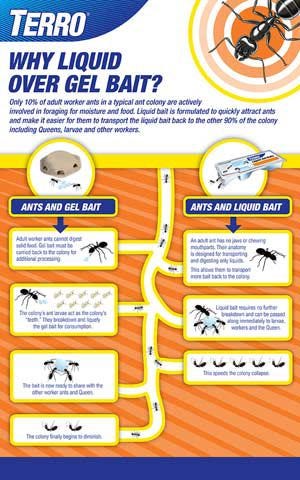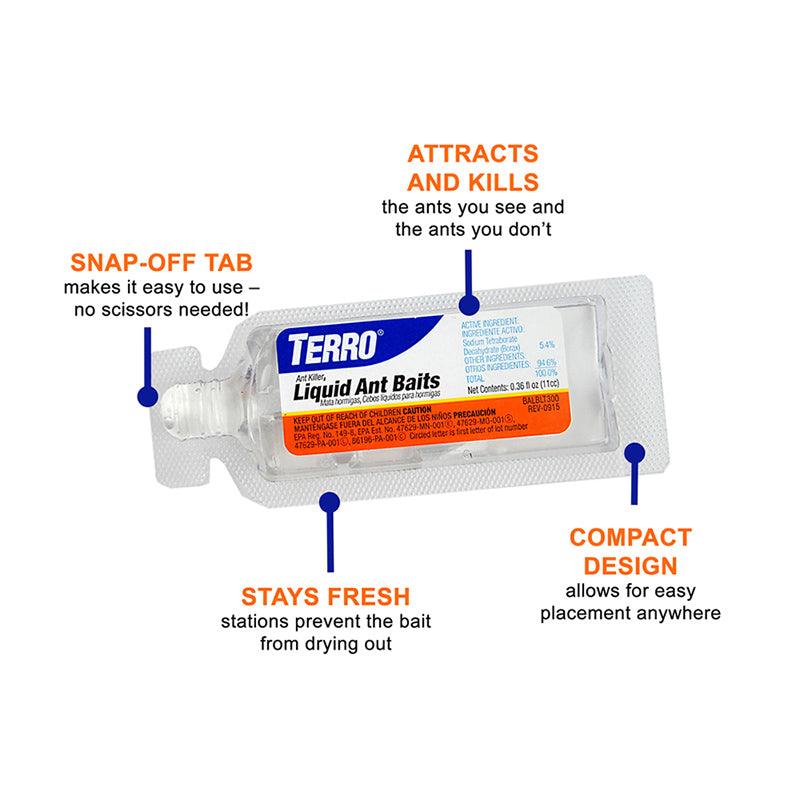To use ant bait traps effectively, place them in areas with known or suspected ant activity, such as under kitchen cabinets or behind furniture. It’s important to avoid sunlight and moisture, as they can decrease the effectiveness of the bait.
Make sure to place the traps in cool, dry, and dark areas for maximum efficacy. Additionally, consider placing the traps near entry points from the outside, drains, kitchen cabinets, and wall openings. By following these placement guidelines, you can maximize the effectiveness of ant bait traps and effectively manage ant infestations in your home.
Understanding Ant Bait Traps
Ant bait traps are an effective way to control and eliminate ant infestations in your home. By understanding how to properly use ant bait traps, you can target the source of the ant problem and prevent future invasions.
Types Of Ant Bait Traps
There are several types of ant bait traps available, each designed to target different species of ants and specific infestation scenarios. Common types include:
- Terro Ant Bait Traps
- Advion Ant Bait Gel
- Combat Max Ant Killing Gel
- Rescue Ant Baits
Each type of ant bait trap has unique features and benefits, so it’s essential to choose the right one for your specific ant problem.

Credit: www.homepest.com
How To Use Ant Bait Traps Effectively
To use ant bait traps effectively, place them in areas where ants are active, such as under kitchen cabinets, behind furniture, or near entry points. Keep the traps in cool, dark, and dry areas for maximum effectiveness. Proper placement will ensure that the ants find the bait, consume it, and carry it back to the nest for elimination.
Placement Of Ant Bait Traps
For effective use of ant bait traps, proper placement is crucial. The bait should be placed in known or suspected ant activity areas. Look for signs of ant trails, such as droppings or visible movement. Common areas to consider include under kitchen cabinets, behind furniture, in the basement or attic, or other possible points of entry from the outside. By placing the bait traps in these areas, you are increasing the chances of attracting and eliminating the ant colony.
Remember, sunlight and moisture can cause the baits to age and lose their effectiveness. To ensure maximum efficiency, place the bait traps in cool, dry, and dark areas. This will help preserve the bait, prolonging its effectiveness and attracting ants for a longer period of time.
Factors Affecting Effectiveness
Several factors can affect the overall effectiveness of ant bait traps. By being aware of these factors, you can optimize the results and eliminate the ant problem efficiently.
- Type of Ant: Different ant species may have varying preferences for food. Make sure to use bait traps specifically designed for the type of ant you are dealing with. This will increase the chances of attracting and eliminating the specific ant species more effectively.
- Placement: As mentioned earlier, proper placement of the bait traps is key. Placing them near areas of ant activity and in spots that are likely to attract ants will increase the chances of success.
- Eliminate Other Food Sources: Ants are attracted to food sources, so it’s important to keep your space clean and remove any exposed food or crumbs. By reducing alternative food options, ants will be more likely to take the bait from the traps.
- Patience: Ant bait traps may not provide instant results. It can take time for ants to discover the bait, consume it, and carry it back to the colony. Be patient and avoid disturbing the bait traps during this process, as it may interrupt the ants’ feeding pattern.
In conclusion, using ant bait traps effectively involves proper placement and considering factors that may affect their effectiveness. By strategically placing the traps and being patient, you can successfully eliminate ants and maintain a pest-free environment.
Do Ant Bait Traps Really Work?
Ant bait traps can effectively eliminate ant colonies by attracting ants to the bait and delaying the effects to ensure they take it back to the nest, wiping out the entire colony gradually. Proper placement in high-traffic ant areas maximizes the traps’ effectiveness.
Ant bait traps are a popular choice for controlling ant infestations. They attract ants with a sweet or protein-based bait which they take back to their colonies, ultimately leading to the eradication of the entire colony. But do ant bait traps really work? Let’s explore the effectiveness of ant bait traps in different scenarios and the expected timeframe for results.Timeframe For Results
The timeframe for seeing results from ant bait traps can vary depending on the size and severity of the ant infestation. In most cases, it can take anywhere from a few days to a few weeks to notice a significant reduction in ant activity. It is important to be patient and allow the ants enough time to carry the bait back to the colony and distribute it among their fellow insects.During the initial stages, you might observe an increase in ant activity around the bait traps. This is a positive sign as it indicates that the ants are attracted to the bait and are taking it back to the colony. Over time, as more ants consume the bait and bring it back to the nest, the entire colony’s population will decrease, resulting in less ant activity.Effectiveness In Different Scenarios
Ant bait traps are effective in various scenarios and can be used both indoors and outdoors. Whether you’re dealing with sugar-loving ants in your kitchen or protein-seeking ants in your garden, ant bait traps can help eliminate the problem.When using ant bait traps indoors, it is important to place them in areas where ant activity is high, such as around kitchen cabinets, near cracks and crevices, or along ant trails. For maximum effectiveness, make sure to keep the area around the bait traps clean and free of other food sources that may distract the ants.When dealing with outdoor ant infestations, place the bait traps near ant hills or along their foraging paths. You can also strategically place the traps in areas that are likely to attract ants, such as near garbage cans, compost bins, or plants that produce honeydew (a sugary substance that attracts ants).Remember to check and replace the bait traps regularly as the bait may dry out or lose its effectiveness over time. It’s also essential to keep the bait traps away from direct sunlight and moisture, as these can degrade the bait.In conclusion, ant bait traps can be highly effective in controlling ant infestations when used correctly. They work by targeting the entire ant colony rather than individual ants, leading to long-term results. Just be patient and consistent in using the traps, and you’ll soon see a significant reduction in ant activity in your home or garden.| Advantages of Ant Bait Traps | Disadvantages of Ant Bait Traps |
|---|---|
|
|

Credit: www.terro.com
Tips For Using Ant Bait Traps
When using ant bait traps, proper placement and monitoring are key to effectively eliminate ants from your home. Below are essential tips to ensure successful ant baiting:
Tips: Ensuring Ant Attraction to BaitEnsuring Ant Attraction To Bait
- Place ant baits in areas where ants are most active, such as near entry points, along ant trails, or under kitchen cabinets.
- Opt for baits that target the specific type of ants you are dealing with for enhanced effectiveness.
- Keep the bait traps away from strong-smelling cleaners or repellents that may deter ants from approaching them.
Monitoring And Adjusting Placement
- Regularly check the bait traps to ensure ants are feeding on the bait. If the bait is untouched, consider repositioning the traps.
- Adjust the placement of the bait traps based on ant activity, moving them closer to ant trails or entry points if necessary.
- Replace bait traps as needed to maintain their effectiveness, especially if the bait becomes dried out or contaminated.
For further information on using ant bait traps effectively, refer to reputable sources such as Terminix and The Home Depot.
Common Questions About Ant Bait Traps
Ant bait traps are an effective method for controlling ant infestations, but there are some common questions that people often have when it comes to using them. In this section, we will address some of the frequently asked questions regarding ant bait traps.
Variability Of Effectiveness
One commonly asked question about ant bait traps is the variability of their effectiveness. It’s important to understand that the effectiveness of ant bait traps can vary depending on several factors such as the type of bait used, the species of ants present, and the placement of the traps.
Compatibility With Different Ant Species
Another common question is about the compatibility of ant bait traps with different ant species. Not all baits are effective for every ant species, so it’s crucial to choose a bait that is specifically designed for the type of ants you are dealing with. Understanding the behavior and preferences of the ant species will help in selecting the most compatible bait.

Credit: www.groworganic.com
Frequently Asked Questions On How To Use Ant Bait Traps
What Is The Best Way To Use An Ant Trap?
The best way to use an ant trap is to place it in areas where you see ant activity, such as under kitchen cabinets or behind furniture. Make sure to put the trap in cool, dry, and dark areas for maximum effectiveness.
Avoid sunlight and moisture, as it can cause the bait to age.
How Long Does It Take For Ant Bait Traps To Work?
Ant bait traps typically take around 1-2 weeks to work. It’s important to place the traps in areas where you see ant activity, such as under kitchen cabinets or behind furniture, for maximum effectiveness. Avoid exposing traps to sunlight and moisture.
Where Is The Best Place To Put Ant Traps?
Place ant traps near active areas like kitchen cabinets, under furniture, and around entry points. Optimal spots are those dark, cool, and dry.
How Do You Use Ant Killing Bait?
To use ant killing bait, place it in areas with ant activity. Such as under cabinets, behind furniture, and near entry points. Ensure bait is in cool, dry, dark areas for maximum effectiveness. Replace baits if exposed to sunlight or moisture.
Regularly monitor and replenish bait as needed.
Conclusion
Maximize ant bait effectiveness by placing traps strategically in active areas. Ensure baits are in cool, dark spots for best results. Watch ants’ response to the bait for successful eradication. Optimal placement near entry points and activity zones is key.
Stay vigilant for successful ant control.

I’m MD Tanvir, and I bring years of expertise gained from working closely with pest control companies to the forefront. My journey in the industry has inspired me to launch Bug Battler, a platform aimed at equipping people with the know-how to combat pests autonomously. Through Bug Battler, I aim to empower individuals with practical insights to tackle pest infestations effectively.

